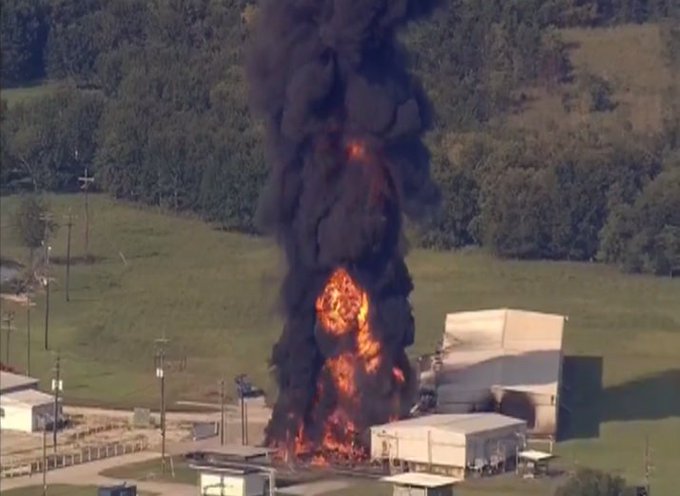
Getty A firetruck waits at a roadblock after a chemical plant operated by the Arkema Group had an explosion during the aftermath of Hurricane Harvey on August 31, 2017 in Crosby, Texas. Local emergency officials reported two explosions Thursday at a flooded chemical plant in the Texas town of Crosby, its operators Arkema Inc said. "At approximately 2:00 am CDT (0700 GMT), we were notified by the Harris County Emergency Operations Center (EOC) of two explosions and black smoke coming from the Arkema Inc plant in Crosby, Texas," the company statement said.
A large fire broke out on September 1 at Arkema, the Houston-area chemical plant that lost power after Hurricane Harvey and that has sparked safety concerns.
You can watch live video from the scene by KATU-TV here:
The plant has caused concerns since it was rocked with a series of previous explosions after Hurricane Harvey, The New York Times reported. The September 1 fire is but the latest problem at the plant outside flood-ravaged Houston.
The smoke has worried many; 15 public safety officers were previously treated at a hospital after inhaling it, The Times reported. The Arkema plant was identified as “one of the most hazardous in the state,” according to The Times.
According to NBC News, authorities had previously warned that “further blasts were likely to occur on site since chemicals weren’t being stored at the appropriate temperatures after the facility lost power following” Harvey.
Residents who live in a 1.5 mile radius of the plant were previously evacuated, NBC reported.
The plant is located about 20 miles from Houston in Crosby, Texas. “The plant manufactures organic peroxides commonly used in everyday products like kitchen countertops, industrial paints, polystyrene cups and plates, and PVC piping,” according to NBC.
ABC News explained, “The chemical plant has lost power and refrigeration capabilities due to Harvey and its aftermath, causing organic peroxides stored in containers at the facility to become unstable and break down as they are exposed to the Texas heat.”
After the previous incidents, Arkema spokesman stressed that the problem was a fire, not a chemical release.
Arkema CEO Rich Rowe Rowe previously said “any smoke coming from the containers will irritate the eyes, nose and lungs, and may cause nausea or drowsiness, the same health effects ‘as you would [have] with any other smoke,'” ABC News reported.
The Environmental Protection Agency said in a statement Thursday night “that the best course of action was to allow the containers holding organic peroxides to burn out instead of putting emergency responders in harm’s way. The agency noted that its aerial surveillance aircraft did not detect toxic concentrations of chemicals at the plant,” ABC News reported, quoting an EPA statement as saying: “Following this fire, EPA sent aerial surveillance aircraft to test resulting smoke and did ground-level air quality monitoring. EPA’s plane instrumentation is capable of measuring 78 different chemicals, including peroxides. Neither testing methods found toxic concentration levels in areas away from the evacuated facility.”

